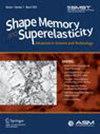安全氟化物水溶液化学蚀刻增强粉末床熔融镍钛表面粗糙度分析
IF 2.4
Q3 MATERIALS SCIENCE, MULTIDISCIPLINARY
引用次数: 0
摘要
本文章由计算机程序翻译,如有差异,请以英文原文为准。
Roughness Analysis of Powder-Bed Fused Nickel–Titanium Surfaces with Chemical Etching Enhancement by a Safe Aqueous Fluoride Solution
求助全文
通过发布文献求助,成功后即可免费获取论文全文。
去求助
来源期刊

Shape Memory and Superelasticity
MATERIALS SCIENCE, MULTIDISCIPLINARY-
CiteScore
4.20
自引率
13.60%
发文量
39
期刊介绍:
The Shape Memory and Superelasticity journal invites original peer-reviewed papers that focus on shape memory materials research with contributions from materials science, materials engineering, experimental and theoretical mechanics, mathematics and physics. Of particular interest is to understand the response of these materials to external stimuli such as force, displacement, temperature, magnetic fields, irradiation, corrosive media and so on in pursuit of uncovering new phenomenon, new materials and new applications as follows: (i) the journal papers will examine these materials utilizing the principles of continuum mechanics, micromechanics, microstructuraly informed constitutive modeling, atomistic models, mathematics of microstructures and other methodologies. (ii) the development and use of advanced experimental techniques to expose and understand the shape memory response including thermal and mechanical cycling, application of magnetic and other external fields, (iii) the exploration and further understanding of shape memory materials due to fatigue, fracture and environmental factors are of significant interest, (iv) novel applications of the materials will be explored in all areas including bio-medical devices, actuators, thin films, robotics, mechanical and aerospace engineering components, civil engineering structures, and micro-electromechanical systems (MEMS). Specifically, the journal will include the following topics: (1) Behavior of all classes of shape memory materials including metals, non-metals (such as shape memory ceramics, shape memory polymers) and shape memory composites, (2) Stress-strain response in thermo-mechanical loadings (experimental observations and modeling), (3) Life prediction methodologies (different approaches including fracture mechanics, role of grain boundaries, the role of slip and twinning on shape memory behavior, crack nucleation modeling), (4) Thermodynamics of the transformation, the fundamentals of superelasticity and related areas such as twinning, detwinning, residual martensites, (5) Solutions of shape memory problems in industry (including biomedical, electronic, MEMS, microdevice and microactuator applications and applications in aero-, civil-, mechanical, electrical and other engineering disciplines), (6) Critical experiments that shed insight into shape memory behavior including digital image correlation, diffraction methodologies (including those using high energy sources), in-situ microscopy, infra red imaging techniques, and conventional and nano mechanical testing methods, (7) Novel experimental techniques for shape memory response (ranging from specimens of micron size, wires, laboratory specimens, rings, bent beams, complex shapes to components, and complex loading conditions), (8) Single Crystals and polycrystals of shape memory metals highlighting the role of texture and orientation effects on superelasticity and recoverable strain levels, and the role of different processing methods on the SMA response, (9) Shape memory response under coupled mechanical-magnetic fields, irradiation effects, magnetic shape memory and thermo-caloric effects, high temperature applications, (10) Alloy design (with cognizance of the chemical composition of underlying phases and crystallography) to tailor the properties to achieve shape memory materials with improved functionality in applications, (11) Surface engineering, corrosion and interaction of SMAs with fluids, behavior of shape memory thin films, and shape memory at nanoscale, (12) Application of atomistic methods (density functional theory and molecular dynamics) to gain insight into properties of such materials and enlighten shape memory alloy design with these materials, (13) Production and processing of shape memory alloys, including shape memory metals, shape memory polymers, shape memory ceramics, thin films, nanosize objects and specimens, and hybrids. Niche- The Journal of Shape Memory and Superelasticity supplies the readers with knowledge focused on shape memory materials and highlighting contributions that could influence other disciplinary fields in engineering, sciences, and medicine. The journal brings together the latest innovations in this ever-expanding field. The journal provides a forum for researchers, scientists and engineers of varied disciplines to access information about shape memory materials. The journal is aimed at disclosing the most pertinent needs in this area and providing a systematic approach to address these needs with experiments, theory and simulation. Articles are authored to describe results from original research and provide technical information that can be appreciated by readers in the subdisciplines while providing significant results that may foster research in applications and related areas. Therefore, the information provided can be utilized in many different disciplines, including medical device design, energy harvesting, structural damping and so on.
 求助内容:
求助内容: 应助结果提醒方式:
应助结果提醒方式:


